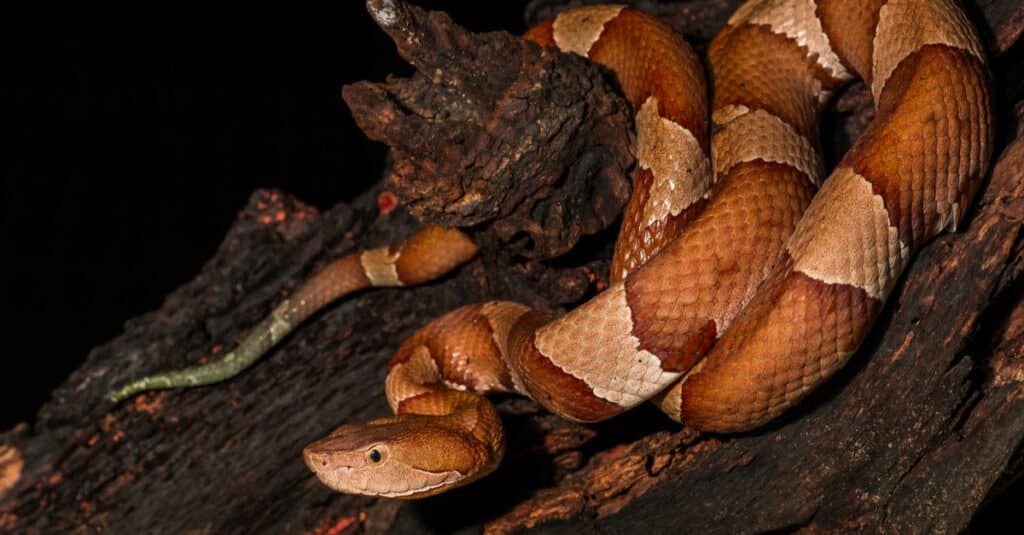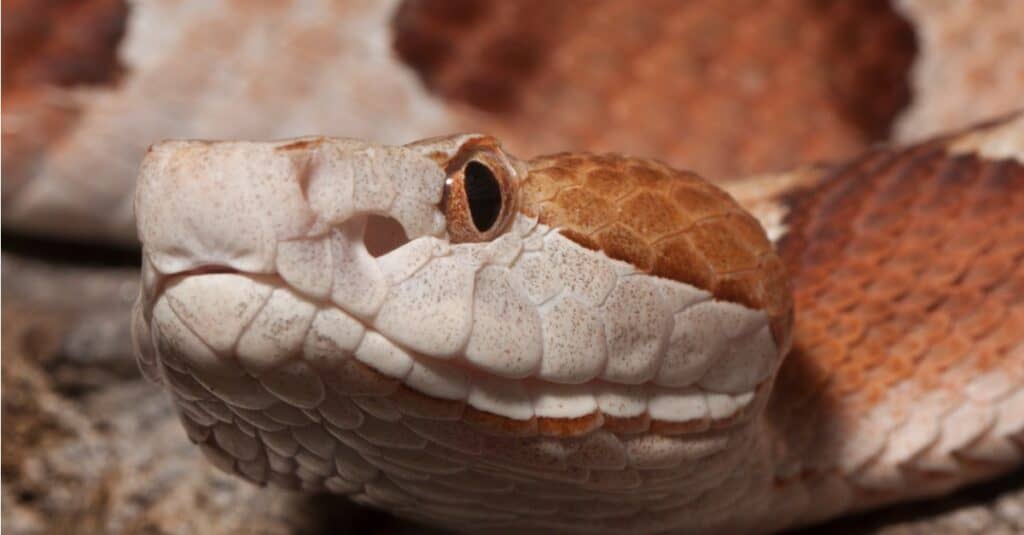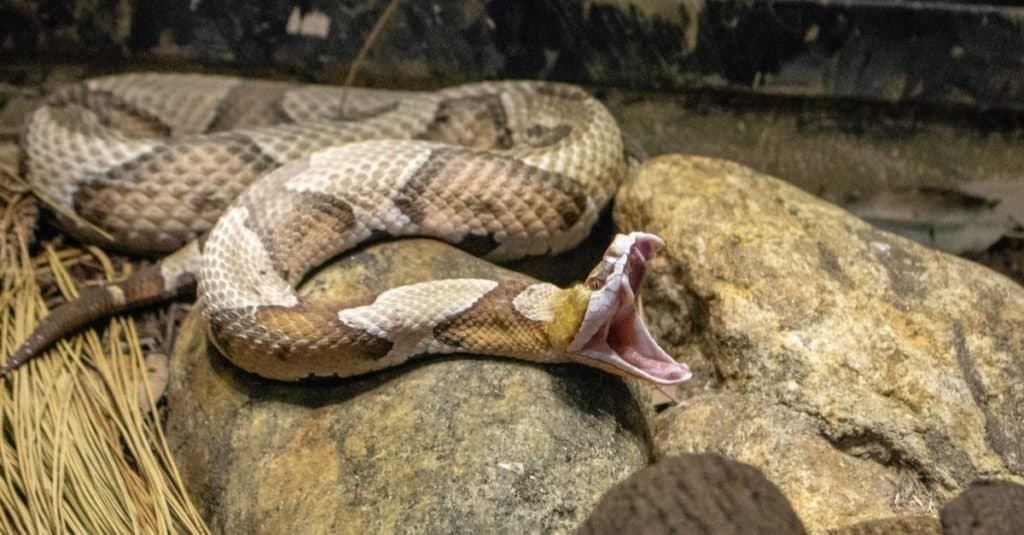Copperheads are among the most common snakes in North America. Although they are venomous, their bites are rarely fatal to people. These snakes get their name from their copper-red heads. North American copperheads are found in Missouri, Arkansas, North Carolina, Tennessee, Louisiana, Mississippi, Alabama, Kentucky, West Virginia, Texas, and Georgia. The eastern copperhead is one of Louisiana’s most common and easily identified venomous snakes. Let’s learn about copperheads in Louisiana!

The copperhead’s scales are keeled, and their eyes have vertical pupils that make them resemble cat eyes.
©Creeping Things/Shutterstock.com
Copperhead Brumation Period In Louisiana

Copperheads undergo brumation in the winter.
©Wildvet/Shutterstock.com
Snakes and other reptiles go into brumation during the winter. While brumation is comparable to hibernation, it is not the same. Depending on the weather, snake brumation can start anytime between September and December and continue until March or April. Snakes may also emerge from brumation if the weather changes, warming their blood and causing them to become more active.
Most Active Periods for Copperheads in Louisiana

Copperheads are most active in the summer.
©iStock.com/Mark Kostich
Peak Seasons
Copperheads love to eat frogs and rodents and are most active in the summer, especially late at night and early in the morning. They aren’t aggressive, but they’re dangerous since they’re often motionless and well-hidden. They rely on their bodies’ ability to blend in with their environment to find prey and elude predators between early spring and late fall.
Time of the Day
Southern copperheads are diurnal, which means they are active during the day from early spring to late fall when they rely on their bodies’ ability to blend in with their environment to find prey and avoid predators.
Most Active Areas for Copperheads in Louisiana
Counties
The eastern copperhead is one of Louisiana’s most common and easily identified venomous snakes. Except for the coast and plains of southwest Louisiana, this species can be found across the state. Except for four counties in Louisiana, it is found in every county. Copperheads are one of four species that can be found along the Mississippi River or in city parks like City Park.
Cities
New Orleans is distinct from other cities in that it is surrounded by water and wetlands. Most visitors are unaware that these landscapes are surrounded by metropolitan areas. The city’s main attractions are the Mississippi River and Lake Pontchartrain. The Bayou Sauvage National Wildlife Refuge is also close to the French Quarter in New Orleans. Copperheads can be found in New Orleans.
Environments
Copperheads are mostly found in rural areas in Louisiana, but they can even be found in urban areas. They are frequently discovered in potted plants or under leaf heaps. Brown snakes are likely to be found under or near mounds of plants. Copperhead snakes usually hibernate in rock-based dens. They also frequently make their homes inside logs and holes cut out by mammals. Stones, sawdust heaps, stumps, and caverns are also common den sites for these snakes. You might be looking at a copperhead winter den if you see any of these things.
What Do Copperheads Look Like?

Copperheads have deep brown hourglass-shaped crossbands on their bottom side.
©Suzanna Ruby/Shutterstock.com
The copperhead is another venomous snake found in Louisiana. It’s commonly beige, tan, or light gray in color. The snake has a dull pink or orange tinge on top, with broad, deeper brown hourglass-shaped cross-bands on the bottom sides that are significantly paler.
A fully grown, mature copperhead measures between 24 and 36 inches in length. Copperheads are about 7-10 inches long when young. Copperheads are sexually dimorphic in size, with females growing longer than males but males having longer tails.
Are Copperheads Venomous?

People with weakened immune systems are more vulnerable to venom snakes, like the copperhead.
©iStock.com/David Kenny
Copperheads are venomous! They have hemotoxic venom, which implies that a bite from a copperhead can cause temporary tissue damage in the bite region. Although their bite can be unpleasant, humans are rarely killed by them. Call 911 right away if you’ve been bitten by a deadly snake. Anti-venom should be injected into your system as soon as possible. Every year, 7,000 to 8,000 persons in the United States are bitten by venomous snakes. Children and people with weakened immune systems are more vulnerable to venom and treatment consequences.
In Conclusion

Snake hunting should be left for the pros.
©Jeff W. Jarrett/Shutterstock.com
Some visitors enjoy looking for snakes in Louisiana’s wetlands, but snake hunting should be left to the pros. Copperheads are one of around 47 snake species found in Louisiana. When temperatures are between 80- and 90-degrees Fahrenheit, copperheads and other snakes are most active. This implies they’ll be most active throughout the spring and summer, especially in the early mornings and late afternoons. As predators and prey for other animals, snakes play a vital role in ecology. If snakes aren’t your thing, keep in mind that most snakes aren’t aggressive unless they’re protecting themselves. It is a great idea to learn about your environment and remember to always be safe and fully aware of your surroundings.
The photo featured at the top of this post is © Scott Delony/Shutterstock.com
Discover the "Monster" Snake 5X Bigger than an Anaconda
Every day A-Z Animals sends out some of the most incredible facts in the world from our free newsletter. Want to discover the 10 most beautiful snakes in the world, a "snake island" where you're never more than 3 feet from danger, or a "monster" snake 5X larger than an anaconda? Then sign up right now and you'll start receiving our daily newsletter absolutely free.
Thank you for reading! Have some feedback for us? Contact the AZ Animals editorial team.






